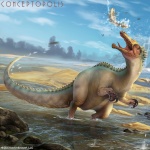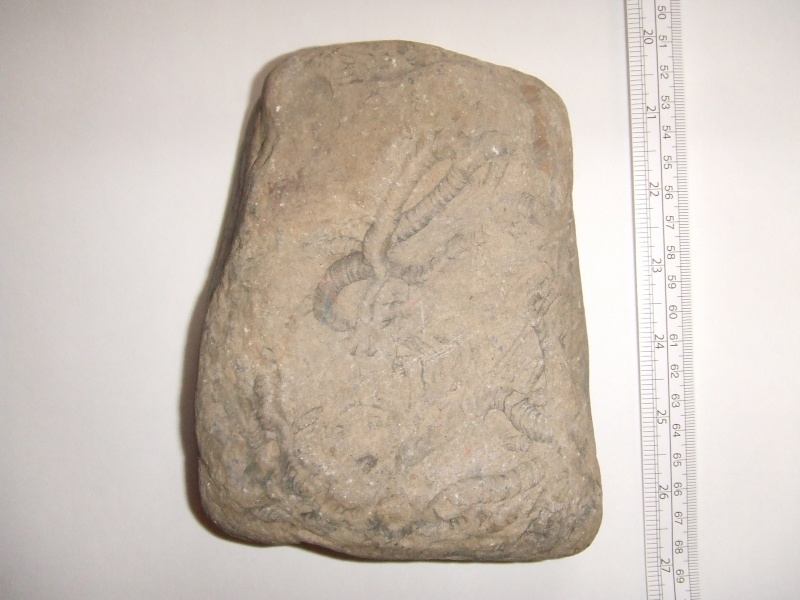5 posters
? any suggestions

stevesnowball- Admin
- Posts : 28
Join date : 2013-03-30
Location : East Sussex
- Post n°3
 Re: ? any suggestions
Re: ? any suggestions
Hi Jen
I'm no expert on Scotland, let alone its fossils but these look like worms . My guess would be Cornulites serpularius or Tentaculites ornatus both Silurian. But I could be completely wrong. Where in Scotland did they come from? It might help pin them down!
. My guess would be Cornulites serpularius or Tentaculites ornatus both Silurian. But I could be completely wrong. Where in Scotland did they come from? It might help pin them down!
Cheers
Steve
*Quick edit: These are not worms. British Palaeozoic Fossils (BM (NH)) lists these as "Class Uncertain", with a Range from Ordovician- Devonian for the former (noted elsewhere as a cricoconarid) and from Ordovician - Silurian for the other.
I'm no expert on Scotland, let alone its fossils but these look like worms
 . My guess would be Cornulites serpularius or Tentaculites ornatus both Silurian. But I could be completely wrong. Where in Scotland did they come from? It might help pin them down!
. My guess would be Cornulites serpularius or Tentaculites ornatus both Silurian. But I could be completely wrong. Where in Scotland did they come from? It might help pin them down! Cheers
Steve
*Quick edit: These are not worms. British Palaeozoic Fossils (BM (NH)) lists these as "Class Uncertain", with a Range from Ordovician- Devonian for the former (noted elsewhere as a cricoconarid) and from Ordovician - Silurian for the other.
Last edited by stevesnowball on Tue Apr 02, 2013 9:02 pm; edited 1 time in total

jenb- Quaternary Rank

- Posts : 25
Join date : 2013-03-22
- Post n°4
 Re: ? any suggestions
Re: ? any suggestions
I don't know Steve, I would guess south east Scotland, I vividly remember finding it..... But I was 7 so not sure where exactly!

ermaster- Silurian Rank

- Posts : 246
Join date : 2012-04-11
Age : 26
Location : Glos
- Post n°5
 Re: ? any suggestions
Re: ? any suggestions
crinoid stem imprints maybe?

jenb- Quaternary Rank

- Posts : 25
Join date : 2013-03-22
- Post n°6
 Re: ? any suggestions
Re: ? any suggestions
I haven't a clue,.I've seen loads of crinoids in the north of England so location may fit, but I've never seen any like this!

macrocephale- Pre-cambrian

- Posts : 533
Join date : 2011-07-20
Age : 31
Location : Avalonia
- Post n°7
 Re: ? any suggestions
Re: ? any suggestions
I've not a clue, a quick Google and I can't see any similarities between that and the worms though. Could be trace fossils, perhaps a burrow/walking trace from an echinoid or something. If I get a chance I'll try and ask a lecturer at uni 

stevesnowball- Admin
- Posts : 28
Join date : 2013-03-30
Location : East Sussex
- Post n°8
 Re: ? any suggestions
Re: ? any suggestions
I've added a quick edit to my first post. Cricoconarida not worms. Always difficult when the bedrock is unknown but Jen, try posting also on the http://www.discussfossils.com forum, where there are a lot of other experts who might help.

jenb- Quaternary Rank

- Posts : 25
Join date : 2013-03-22
- Post n°9
 Re: ? any suggestions
Re: ? any suggestions
ah, thanks guys...... the mystery is unravelling...

stevesnowball- Admin
- Posts : 28
Join date : 2013-03-30
Location : East Sussex
- Post n°10
 Re: ? any suggestions
Re: ? any suggestions
A quick look at a geological map of Scotland reveals mostly sedimentary rocks in the south , ranging from Carboniferous sandstones, mudstones and limestones, through Devonian sandstones to Silurian and Ordovician sanstones and mudstones (in the Southern Uplands region).
So, rocks-wise, your specimen fits. It looks like a sandstone from South East Scotland! Make sure to keep us in the loop when/if you get full verification
Make sure to keep us in the loop when/if you get full verification 
So, rocks-wise, your specimen fits. It looks like a sandstone from South East Scotland!

jenb- Quaternary Rank

- Posts : 25
Join date : 2013-03-22
- Post n°11
 Re: ? any suggestions
Re: ? any suggestions
thanks steve, im relying on someone here to work it out but your info is great.... thank you

stevesnowball- Admin
- Posts : 28
Join date : 2013-03-30
Location : East Sussex
- Post n°12
 Re: ? any suggestions
Re: ? any suggestions

jenb- Quaternary Rank

- Posts : 25
Join date : 2013-03-22
- Post n°13
 Re: ? any suggestions
Re: ? any suggestions
Yep, see what you mean..... excuse my ignorance but Where they like shells?

Chapwi- Admin
- Posts : 665
Join date : 2011-03-27
Age : 38
Location : Kettering
- Post n°14
 Re: ? any suggestions
Re: ? any suggestions
mmmmmmmmmmmmmmmmm!!!!!!!!!!!!!!!!!!
I think Steve is right
I think Steve is right

stevesnowball- Admin
- Posts : 28
Join date : 2013-03-30
Location : East Sussex
- Post n°15
 Re: ? any suggestions
Re: ? any suggestions
Jen, you are quite right. Cricoconarida are of Palaeozoic age and (apparently) are now considered to be a class of Mollusca.
My old handbook was dated 1964, so I expect it's been updated since! I'd never heard of Cricoconarida until now- that's the beauty of these forums, you're always learning! Cricoconarida are defined by having conical calcareous shells with ring-like sculptures.
More at http://books.google.co.uk/books?id=dNvnxWJnxtgC&pg=PA537&lpg=PA537&dq=Cricoconarida&source=bl&ots=aX6IH2IFjj&sig=HCDptgz2uMYUNpCFjyffzfwjEX4&hl=en&sa=X&ei=xThbUbmlJYW7O83jgNAL&ved=0CDMQ6AEwAA#v=onepage&q&f=false
Thats one heck of a URL!

ermaster- Silurian Rank

- Posts : 246
Join date : 2012-04-11
Age : 26
Location : Glos
- Post n°16
 Re: ? any suggestions
Re: ? any suggestions
I think Steve is close on his guess but why would the shell be so contorted without sign of cracks? or is it maybe the imprint left after one or 2 get dragged along the bottom of the seabed causing the weird shapes? I don't know but i'm just suggesting.

jenb- Quaternary Rank

- Posts : 25
Join date : 2013-03-22
- Post n°17
 Re: ? any suggestions
Re: ? any suggestions
2 of the ? Imprints seem to be joined together at the base too ?

ermaster- Silurian Rank

- Posts : 246
Join date : 2012-04-11
Age : 26
Location : Glos
- Post n°18
 Re: ? any suggestions
Re: ? any suggestions
yeah I meant the 1 or 2 as meaning a "couple" and I'm probably wrongjenb wrote:2 of the ? Imprints seem to be joined together at the base too ?
|
|
|





